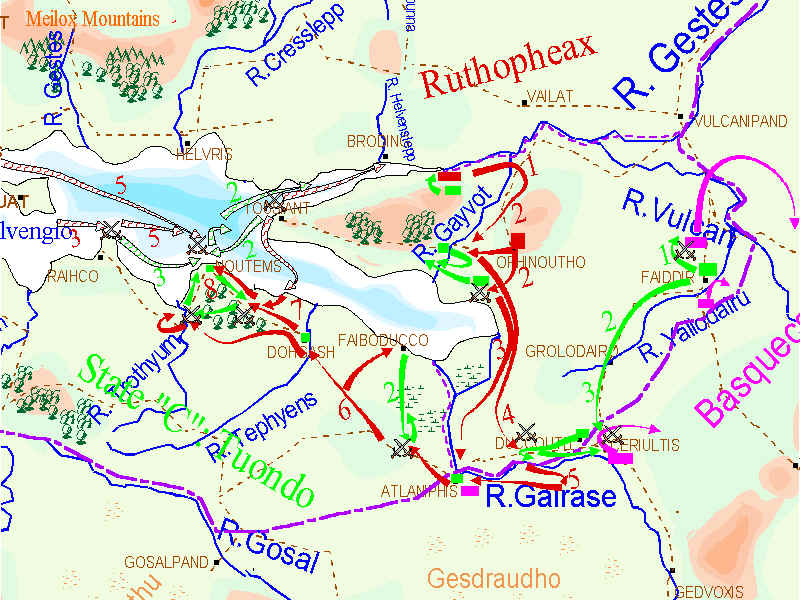|
Home Page
Discovery of Atlantis
First Empire-(1) to 261
Second Empire- (1) 361 - 409 |
|
The wars of Ruthopheax I in detail 4. The War against State "C"
The war between Ruthopheax I and Tuondo, 2: 645
By February 645, Ruthopheax had concentrated his armies into two: the main one, 90000 strong at Ophinoutho, and the smaller one, 40000, in the bridgehead south of the Gestes in Iutieh. 1 on map: His first move was to slip the Iutieh force east across the Gayvot, into Yall. Thiss., and then down its east bank, where it could support the Ophinoutho force. At the same time, Tuondo's Faiddir army finally chased the Basuec army from Vulcanieh back across the river, more or less where it had crossed it many months earlier. 2 on map: In March, the first actions took place at sea. Tuondo's navy attacked Ruthopheax's force blocking the Gestes channel off Tousiant and defeated it, chasing it some way up the Gestes as far as Broding. However, all Ruthopheax's military communications now crossed the Gestes further up the river. The enemy navy then moved most of its forces back to Noutems. Later in the month Ruthopheax began his great offensive from Ophinoutho. He attacked and stormed the enemy position on the hills to the south-west, forcing his opponents to retreat west across the Gayvot into Iutieh. He then left a small force to observe the enemy here. To the east, Tuondo's army from Faiddir had been beginning to move north towrads the Gestes and Ruthopheax's communications. However Tuondo lost his nerve and in April directed this army to move down to Ceriultis, clear off the Basqucs here and prepare to face Ruthopheax. 3 on map: During April and May, Ruthopheax's main army undertook the long march south round the estuary of the river Gairase, making for Atalniphis, which guarded the only approach by land to Manralia and Tuondo's capital and main naval base at Noutems. He was also aware that he would first have to deal with the enemy army to his east, which, moving on Ceriultis and Duccouth, would soon have up to 60000 men. At sea, one of Tuondo's fleets, which had been standing off Raihco for some time keeping an eye on Ruthopheax's naval forces in Giezuat, was attacked, beaten and pursued back to Noutems. However, with the help of reinforcements, it was able to turn on its pursuers soon afterwards and force them back to Raihco. 4 on map: during July, August and September, there took place a series of operations around the river Gairase west of Duccouth. The outcome was that Ruthopheax's forces beat Tuondo's and chased him back, south of the river, towards Ceriultis. 5 on map: eventually most of the forces gave up the pursuit and returned to the main army north of Atlaniphis. The problem now was how to get across the Gairase in the face of strong enemy forces and the fortress of Atlaniphis. It should be noted that Tuondo had evacuated nearly all his forces remaining in Iutieh across the sea to Manralia, whewre they became available to join his defences. He did this just in time, as in October, a large naval force, coming from Atlantis, moved along the Helvengio, joined the other fleets and inflicted a decisive defeat on Tuondo's navy at the Naval battle of Raihco. The crossing of the Gairase only proved possible when Louron had finally persuaded the Basquecs to join in an attack from the south against the Atlaniphic position, along with his own troops marching back westwards along the south of the Gairase. The move into Manralia did not in fact begin until February 646. 646: 6 on map: the First battle of Atlaniphis was a dificult one, as the enemy had had time to entrench himself outside the fortress, which on its own would not have stood up long to Louron's artillery. With help from the Basquecs gained an overwhelming visctory, and over the next three months pursued the enemy all the way north to Dohgash on the river Tephyens. 7 on map: Louron now bypassed the strong position of Dohgash, crossed the river and moved on the capital. In the woods south of Noutems, a battle near the shore in June was not very successful for Louron, as Tuondo was receiving a lot of reinforcements now from Th. Thiss and the west of Manralia. He therefore moved most of his forces westwards, round the south of the woods, aiming to reach the estuary of the river Trothyum, hold off further enemy reinforcements from the west, and make for the capital up the western shore. However, Tuondo was too quick for him, attacked him here on the Trothyum, and forced him actually to retreat across the river. 8 on map: But in reality all was now up for Tuondo. An additional amphibious force now landed south-east of Noutems, and a final push up this side in August led to the final defeat of Tuondo's forces, his capture and the almost bloodless fall of the capital and all the remaining parts of his empire. Tuondo was brought back to Atlantis, humiliated, tortured and publicly executed in 648. That year, amidst great celebrations, Louron was declared Emperor Ruthopheax of a new Empire, the Third.
|
